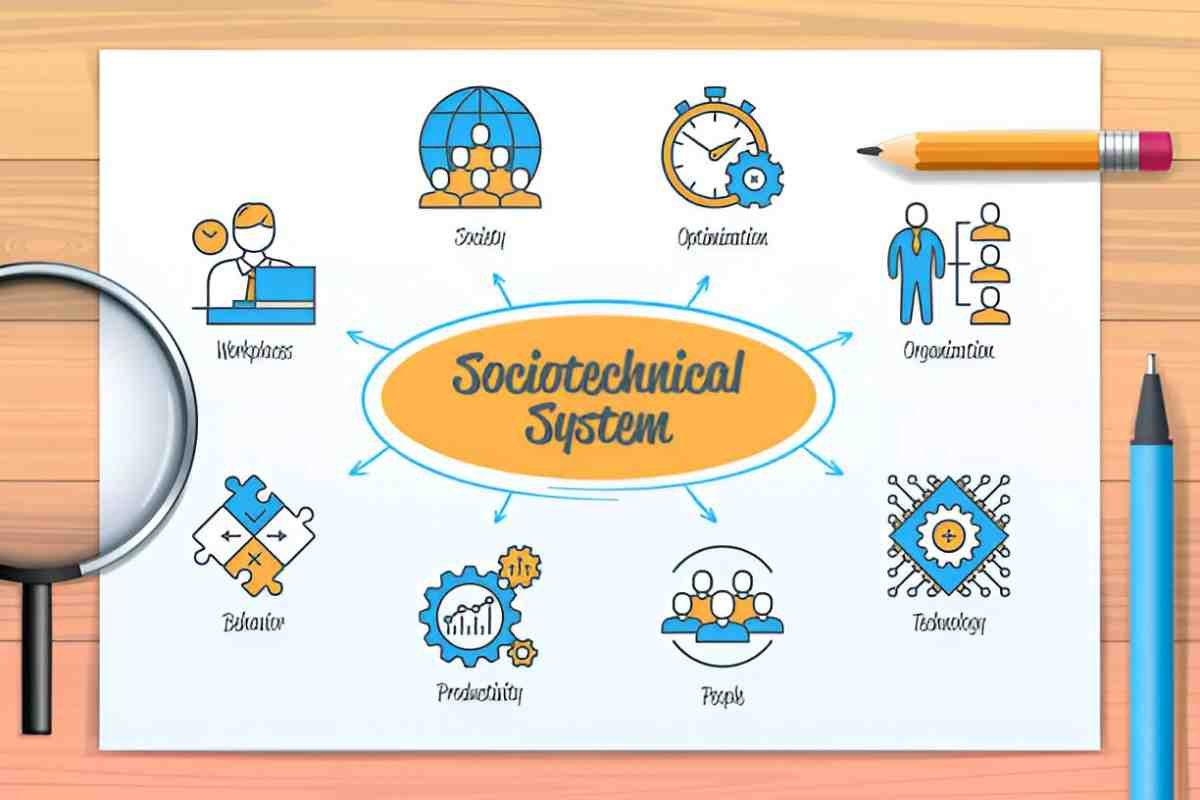In today’s rapidly evolving workplace, achieving harmony between technology and human interaction is no longer a luxury but a necessity. I’m sure you’ve heard the term “socio-technical systems” thrown around, but what exactly does it mean, and why should it matter to you? This article dives deep into the concept of socio-technical systems, breaking it down into simpler terms that anyone, regardless of their background, can understand. I will explain the fundamental components of socio-technical systems, how they apply to real-world scenarios, and why they are key to sustainable productivity and innovation in modern organizations.
Table of Contents
What Are Socio-Technical Systems?
Socio-technical systems (STS) refer to the interaction between society (people, culture, organizational structures) and technology (tools, machinery, processes) within a given environment. The key idea behind STS is that both the social and technical aspects of a system must be designed together to achieve optimal performance and harmony. Historically, many systems focused either on the technical or social side but ignored the other. As a result, issues such as inefficiency, low morale, and poor system performance were common.
The term was coined in the 1950s by engineers at the Tavistock Institute of Human Relations in London. They recognized that workers’ efficiency was influenced not only by the technology they used but also by the work environment and the relationships between people. They found that technology, when implemented without considering the social context, often led to negative outcomes. This realization marked the beginning of integrating both elements in designing work systems.
Why Should We Care About Socio-Technical Systems?
In the workplace, harmony between social and technical elements leads to better decision-making, smoother workflows, and improved overall productivity. When the technical system (the machinery, software, etc.) and the social system (team structures, communication, culture) are well-aligned, both individuals and organizations benefit.
To better understand the importance of STS, consider this example: A company introduces new software for its employees, but the training process is inadequate. Employees struggle to use the new technology, and their frustration leads to decreased morale and productivity. The company’s technical system (the software) was not effectively integrated with the social system (the training, culture, and communication around the change). As a result, the performance of the company suffers.
The Components of Socio-Technical Systems
To understand the power of socio-technical systems, we need to break down their components. These systems consist of several interconnected elements, both technical and social. Let’s explore them in detail.
1. The Technical System
The technical system encompasses all the tools, machinery, and technologies used in the workplace. This includes everything from computers and software to automated machinery and complex information systems. The role of the technical system is to perform specific tasks efficiently and reliably.
For example, in a manufacturing setting, the technical system could include automated assembly lines and robotics designed to improve production efficiency. In an office setting, it might include computers, email systems, and project management tools that help teams collaborate.
2. The Social System
The social system refers to the human elements involved in the process. This includes the people, their roles, the culture of the workplace, communication structures, and the organizational hierarchy. The social system shapes how individuals and teams interact, how information flows, and how decisions are made. It’s often shaped by organizational culture, leadership, and policies.
In our earlier example, the social system would involve how employees are trained on the new software, how leadership communicates the purpose of the change, and how team dynamics are affected. A positive social system fosters collaboration, trust, and effective communication among team members.
3. The Environment
The environment, while not always explicitly mentioned, plays a crucial role in the functioning of both the technical and social systems. This includes the physical environment (the layout of the office or factory floor) and the broader organizational environment (the industry standards, regulations, and market conditions).
In a manufacturing environment, the design of the floor layout—how machines are arranged and how workers move around—affects both the technical and social aspects. If the layout is poorly designed, it may lead to inefficiencies and safety concerns, which will ultimately influence how employees feel about their work environment.
4. The Interface Between Social and Technical Systems
The interaction between the social and technical systems is perhaps the most crucial element of a socio-technical system. This interface is where human workers engage with the technology. It’s the way employees interact with machines, use software, or rely on tools to perform tasks.
The interface should be designed so that it complements the strengths of human workers while taking advantage of the technical system’s capabilities. If the interface is difficult to use or not aligned with how workers think and behave, the whole system may fall apart.
Applying Socio-Technical Systems: Real-World Examples
Now that we’ve broken down the components of socio-technical systems, let’s take a look at how these ideas apply in real-world scenarios.
Example 1: Healthcare Systems
In healthcare, socio-technical systems play a critical role. Consider an electronic health record (EHR) system in a hospital. The technical system includes the software used by doctors and nurses to input and retrieve patient data, while the social system involves the healthcare providers (doctors, nurses, support staff) who interact with the system. If the technical system is complex and not user-friendly, it can lead to errors, frustration, and slower workflows, which negatively impacts patient care.
A well-designed socio-technical system in healthcare would ensure that the EHR system is intuitive for the medical staff and that the hospital provides sufficient training and support to ensure the staff is comfortable with the technology. The environment (such as hospital protocols and patient safety regulations) also plays a significant role in how the system is used.
Example 2: Office Work
In an office environment, socio-technical systems are often seen in the integration of communication tools like email, video conferencing software, and project management platforms. If these tools are difficult to use or not well-integrated, they can disrupt communication, slow down work processes, and lower employee satisfaction.
On the other hand, when an office’s social system (culture, training, and communication strategies) aligns well with its technical system (software and hardware), employees can work more efficiently and harmoniously. For instance, companies that provide proper onboarding, user-friendly tools, and strong communication channels often see better employee engagement and productivity.
How Socio-Technical Systems Impact Organizational Performance
When both the social and technical systems are aligned, organizations perform better. Here’s why:
1. Increased Efficiency
The integration of well-designed technical systems with effective social systems can streamline workflows, automate repetitive tasks, and reduce human error. As a result, work processes become faster and more efficient. For instance, in manufacturing, automated systems that are easy for workers to operate can significantly boost productivity.
2. Improved Employee Satisfaction
When employees feel supported by both their environment and the tools they use, job satisfaction improves. A positive social environment, combined with easy-to-use technology, fosters collaboration, reduces stress, and boosts morale. Employees are more likely to feel engaged when they know they have the necessary tools and resources to do their jobs effectively.
3. Flexibility and Adaptability
Socio-technical systems allow for greater flexibility in adapting to changes. If a company has a well-designed technical system and a robust social system, it can more easily adapt to changes such as the introduction of new technology, shifting market demands, or changes in customer preferences. A company that has invested in creating harmony between the technical and social systems will find it easier to pivot when necessary.
4. Innovation
Finally, when social and technical systems work in harmony, organizations are better positioned to innovate. Employees are empowered to use their creativity and expertise to solve problems, and technology is used as a tool to support innovation rather than a source of frustration. This creates a more dynamic and forward-thinking work environment.
Mathematical Modeling of Socio-Technical System Efficiency
One way to analyze the efficiency of socio-technical systems is through a basic model of system performance. Let’s assume that the performance of a socio-technical system is a function of both the technical system (denoted as T) and the social system (denoted as S). The total system performance P can be modeled as:
P = \alpha T + \beta Swhere \alpha and \beta are weights that represent the relative importance of the technical and social systems in the overall performance.
Example Calculation:
Let’s say a company’s technical system has a performance score of 80 out of 100, and its social system has a score of 70 out of 100. If both systems are equally important, we would have \alpha = \beta = 0.5.
The total performance score would then be:
P = 0.5 \times 80 + 0.5 \times 70 = 40 + 35 = 75In this example, the company’s overall system performance is 75 out of 100. This simple calculation shows how different components of the socio-technical system contribute to overall efficiency.
Conclusion
Socio-technical systems are vital for ensuring that organizations operate smoothly in a world where technology is increasingly interwoven with human work. By understanding and optimizing the interaction between the social and technical systems within an organization, companies can improve efficiency, employee satisfaction, adaptability, and innovation. Whether you are in a healthcare setting, an office, or a manufacturing plant, the integration of these systems is crucial for success. The more you invest in ensuring harmony between technology and people, the more effective your organization will be.





